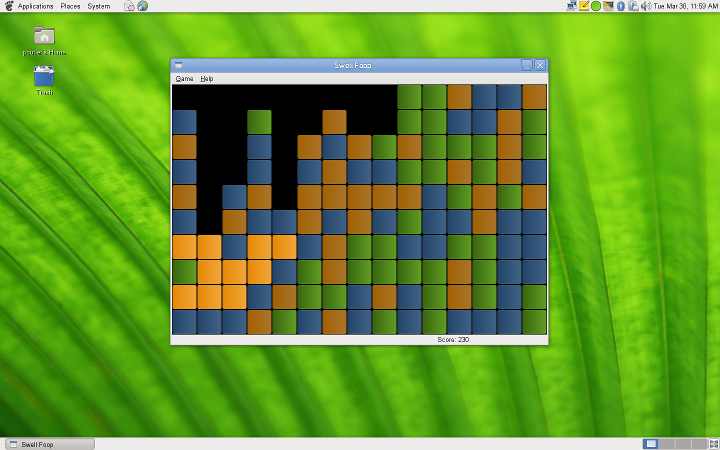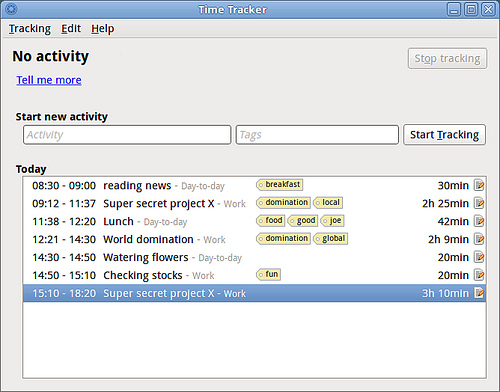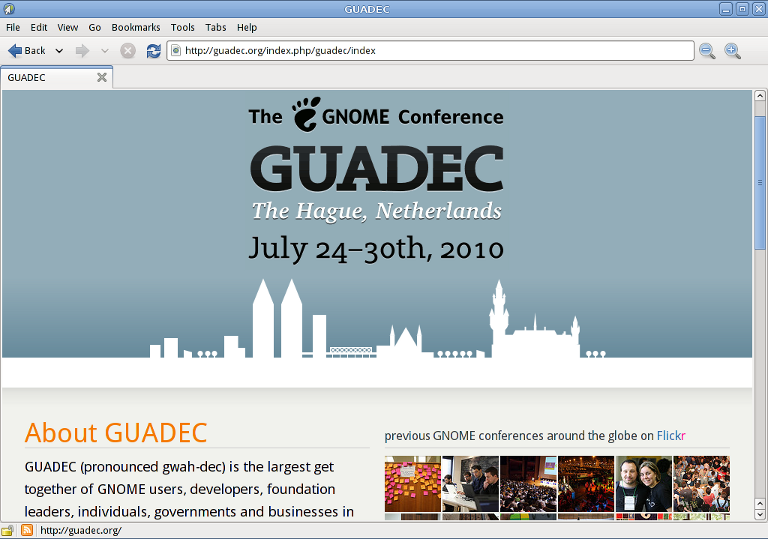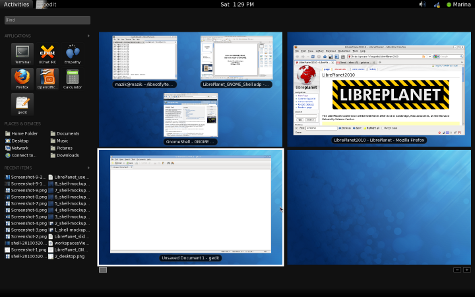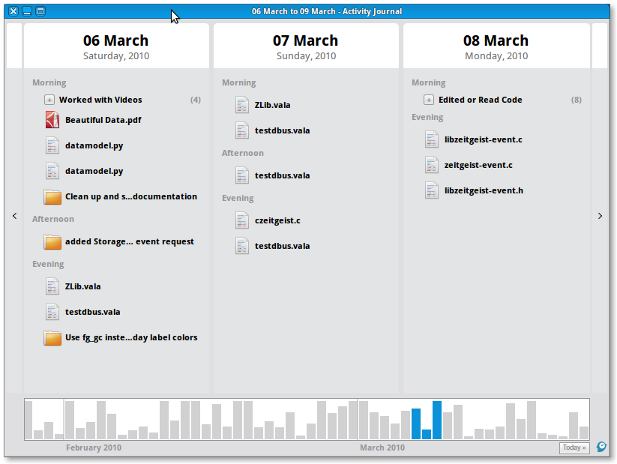GNOME 2.30 Release Notes
1. Introduction
GNOME 2.30 is the latest version of the GNOME Desktop: a popular, multi-platform desktop environment for your computer. GNOME's focus is ease of use, stability, and first-class internationalisation and accessibility support. GNOME is Free and Open Source Software and provides all of the common tools computer users expect of a modern computing environment, such as e-mail, groupware, web browsing, file management, multimedia, and games. Furthermore, GNOME provides a flexible and powerful platform for software developers, both on the desktop and in mobile applications.
The GNOME Desktop is released every six months and contains many new features, improvements, bug fixes, and translations. GNOME 2.30 continues this tradition. To learn more about GNOME and the qualities that distinguish it from other computer desktop environments (such as usability, accessibility, internationalisation, and freedom) visit the About GNOME page on our website.
Join us today and see what a difference you can make.
GNOME 2.30 includes all of the improvements made in GNOME 2.28 and earlier. You can learn more about the changes that happened in GNOME 2.28 from its release notes.
2. Get your GNOME Gear!
The GNOME Foundation is proud to announce the opening of the GNOME Store, powered by Zazzle. You can help support GNOME by buying T-shirts and mugs in the new GNOME Store. Visit the GNOME store and show your support for GNOME today!
Friends of GNOME is a way for individuals to support the GNOME project's mission of providing a free and open source desktop for everyone regardless of ability. With no advertising or outreach, the Foundation has raised almost £20,000 in 2009 from generous individuals. That money has contributed to the funds for hackfests, local events and programmes which in turn have enabled the GNOME project to create internationalised, accessible and easy to use desktop software for both traditional desktops and for mobile devices.
Head over to the Friends of GNOME website.
3. What's New for Users
The GNOME Project's focus on users and usability continues in GNOME 2.30 with its hundreds of bug fixes and user-requested improvements. The sheer number of enhancements makes it impossible to list every change and improvement made, but these notes aim to highlight some of the more exciting, user-oriented features in this release.
- 3.1. View More Files
- 3.2. Empathy Instant Messenger
- 3.3. Easy Syncing
- 3.4. Manage Your Users Safely
- 3.5. Know What You're Doing
- 3.6. Manage your PDFs
- 3.7. Browse the Web
- 3.8. Connect Remotely
- 3.9. But Wait, There's More…
3.1. View More Files
GNOME 2.30 includes updates to Nautilus, the GNOME File Manager. Nautilus features a number of user interface changes including a new split view mode and is now set to browser mode by default, replacing spatial mode.
3.2. Empathy Instant Messenger
GNOME's instant messaging and communication application, Empathy, built on the Telepathy communications framework, has gained a number of new and important features to help users communicate.
Empathy will now display an information bar in the contact list when an account fails to connect, featuring a button that makes it easy to try and connect again or edit the account settings.
You can now send files by dragging and dropping a file in the contact list or in the chat window when talking to a friend.
Empathy's IRC functionality has been updated to include support for common IRC commands such as /join or /nick, and you can now join password protected rooms.
Other updates include support for easily adding and configuring Facebook chat and chat windows now display a search window to help easily find text when chatting with friends.
3.3. Easy Syncing
Tomboy Notes features a number of updates and now can automatically synchronise your notes in the background instead of requiring you to manually sync. You can also set how often Tomboy should sync automatically from within Tomboy's preferences.
Tomboy's startup time has been dramatically improved and now starts almost instantly.
Copying and pasting has been improved and you can now copy and paste rich HTML from notes into other applications such as OpenOffice.org, Evolution or other applications. The formatting of your notes is preserved, assuming the application you are pasting information into understands HTML.
Other improvements in Tomboy include Microsoft Windows 7® jump list support with Tomboy being present in the Taskbar and Windows Start Menu. Renaming notes in Tomboy has been improved to offer safer renaming of notes and give you more control when renaming a note so you don't accidentally rename links in other Tomboy notes.
3.4. Manage Your Users Safely
GNOME System Tools has a number of new improvements making it easier and safer to manage users on your computer. GNOME System Tools now works with PolicyKit for authentication, removing the button for managing users and services.
The dialogue to create a user has been improved and only requires you to provide the new user's name and will include user name suggestions. Upon account creation everything will "just work"! This also includes adding support for encrypted home directories for new users.
You can no longer lose your own administrative rights accidentally. You will now be prompted for your current password before changing your password so your keyrings and encrypted home directories will not break. When removing user accounts, the ability to delete that user's home directory is now an option.
When managing existing users you can choose from specific account types rather than having to choose specific cryptic privileges making it easier to add and remove abilities for other users.
3.5. Know What You're Doing
The Time Tracker applet, which helps you track your time and tasks, includes a number of new improvements.
An all new standalone mode has been created in addition to the panel applet. Depending on your distribution, Time Tracker is available in your GNOME Menu under .
Viewing and creating reports based on your activities has been improved as you can now create tags in your activities and the overview can also be filtered by all aspects of your activities.
3.6. Manage your PDFs
The Evince document viewer has improved printing support. Page setup settings are now embedded in the print dialogue and a new tab has been added to support various scaling options.
Evince on Microsoft Windows® now includes support for printing, PostScript and comics.
Other updates to Evince include adding an inverted colours mode; updates to presentation mode; the ability for annotation in PDF file attachments and support for remote files in the thumbnailer.
3.7. Browse the Web
The Epiphany web browser has seen numerous bugs and regressions fixed in addition to new features.
Epiphany can now remember passwords using gnome-keyring.
Epiphany has a new configuration option to enable or disable all plugins, such as Flash or Java. Epiphany will also now warn you when viewing a website with a broken SSL certificate.
Features that have returned to Epiphany include:
- Print preview is again available.
- You can now right-click in a web page to download and save an object, such as an image.
- Favicon support has been restored.
- The up navigation arrow has returned.
- When you middle-click with your mouse, your clipboard contents will be pasted.
- Epiphany's context menus have returned and are compatible with custom page menus, such as those used by Google Docs.
Epiphany also has added advanced options available as settings in GConf. You can enable support for User Agents and change your default search engine directly within GConf.
Epiphany-extensions has new additions including html5tube which replaces YouTube Flash with HTML5 and does not require you to have Flash installed. The tab-key-tab-navigate plugin allows you to use Ctrl+Tab to change tabs. The sidebar extension has been removed.
3.8. Connect Remotely
Vinagre, a remote desktop client for the GNOME Desktop, has added support for SSH tunnelling allowing you to access a remote machine more securely through an SSH tunnel. You will need an SSH account on the remote client and then you can type in passwords and other information knowing you are connected securely.
Connecting to clients using a low bandwidth connection has been made easier by allowing you to choose a lower depth of colour to save bandwidth and by enabling JPEG compression. These options are available in the connection dialogue in Vinagre.
A new listener mode has been added allowing the remote desktop you are going to view and control to connect to you. This is helpful when the remote connection is behind a firewall or router and is unreachable through the normal connection process. By enabling listener mode in Vinagre and giving your IP address to the user you are trying to connect to, the remote client can connect to you.
3.9. But Wait, There's More…
As well as big changes, there are also various small additions and tweaks that happen in every GNOME release.
- New fonts can be installed by double-clicking the font in Nautilus.
- Gedit has improved integration in the Mac OS® X port and Python plugins are now working in the Windows version. Gedit's Snippets plugin has been ported to the new completion framework. The spell check plugin now has the ability to check comments and strings in programming languages.
- When you choose multiple keyboard layouts the status icon automatically appears in the notification area.
- File Roller will install the necessary packages using PackageKit if an archive you are trying to open does not have the correct archive support installed.
- Brasero will now more accurately copy audio CDs using the cdda2wav plugin. Brasero is now integrated with PackageKit and has support for searches using Tracker.
- GNOME Terminal now has support for unlimited scrollback, scrollback saving and bold colours.
- iPod® and iPod Touch® devices are now partially supported by gvfs thanks to the libimobiledevice library. Music synchronisation, data access and downloading photos should be fully supported. For a full list of feature support, libmobiledevice homepage.
- gcalctool features a new, simpler user interface. Functions are now typed, such as s_i_n for sine instead of k.
- In addition to a number of bug fixes, GNOME Panel has fixed a long outstanding bug in that when you change your screen resolution, applets will no longer randomly change position.
- The GNOME Keyboard Indicator has been removed from GNOME Applets. If you use more than one keyboard layout, the GNOME Keyboard Indicator will now automatically appear in your tray via gnome-system-daemon.
- GNOME Keyboard Preferences in the GNOME Control Centre has an updated graphical user interface.
- GNOME Games have renamed Gnometris to Quadrassel and Same GNOME is now known as Swell Foop. Swell Foop and Gnibbles both have a new 3D accelerated engine based on Clutter.
4. What's New in Accessibility
GNOME has a passion for making software available to everyone, including users and developers with impairments that can make it harder to use their computers. To help, GNOME created the GNOME Accessibility Project and an accessibility framework that is now a standard on libre desktops.
GNOME 2.30 continues to build on its prior accessibility credentials with several improvements.
4.1. Orca Screen Reader
The Orca screen reader has had significant work done to reduce program bugs and improve performance, with over 160 bugs fixed for GNOME 2.30. Some of the improvements include:
- The preferences user interface has been updated to improve Orca on netbooks.
- You can now run orca --replace to start a new Orca process that also kills all other running Orca processes.
- Orca now has a new "About" dialogue.
4.2. Other Accessibility Updates
A significant amount of work has gone into GNOME Accessibility to remove Bonobo. The D-Bus implementation of AT-SPI has been made to work side by side with the CORBA implementation. GNOME 2.30 is the last official release that will support the CORBA implementation with D-Bus replacing CORBA in GNOME 3.0.
If you are passionate about making GNOME accessible for all users, now is a great time to join the Accessibility team. Help make GNOME better for users with disabilities and join the GNOME Accessibility mailing list to learn more.
5. What's New for Developers
The following changes are important for developers using the GNOME 2.30 developer platform. If you're not interested in changes for developers, you can skip forward to Section 6 ― Internationalisation.
As well as the GNOME Desktop, GNOME 2.30 is the latest release of the GNOME Developer Platform, a set of API- and ABI-stable libraries available under the GNU LGPL which can be used for the development of cross-platform applications.
Starting with GNOME 3.0, various deprecated parts of GNOME will be removed. These deprecated components include libraries such as libart_lgpl, libbonobo, libbonoboui, libglade, libgnome, libgnomecanvas, libgnomeprint, libgnomeprintui, libgnomeui, and libgnomevfs. For applications that ship as part of the GNOME Desktop, a number of cleanup tasks have been carried out to ensure no deprecated code is used. This will ensure a smooth transition to GNOME 3.0.
Developers are strongly urged to follow this example in their own applications too. Furthermore, for any developers (or potential developers) who wish to help us out, the GNOME goals wiki page lists the various tasks that are yet to be completed. An automatically created and updated status overview of remaining work for modules that are supported by the jhbuild build tool can be found here.
- 5.1. Platform Cleanup
- 5.2. GTK+ 2.20
- 5.3. Empathy
- 5.4. Anjuta
- 5.5. GNOME Platform Improvements
5.1. Platform Cleanup
Large efforts have been undertaken to remove deprecated modules and functionality on the way to GNOME 3.0.
Many applications have also removed the usage of deprecated GTK+ and GLib symbols and have applied the new policy to only include top level headers of GTK+ and GLib.
5.2. GTK+ 2.20
GTK+ 2.20 is the latest release of the GTK+ toolkit, which is at the heart of GNOME. GTK+ 2.20 includes new features for developers, as well as extensive bug fixing and housecleaning for the upcoming GTK+ 3.0.
GTK+ has also seen a number of other improvements, including:
- A throbber widget, GtkSpinner, and cell renderer, GtkCellRendererSpinner have been added.
- GtkToolPalette is a new container to show tool items in collapsible groups.
- GtkNotebook can now have action widgets next to tabs.
5.3. Empathy
libempathy and libempathy-gtk have been removed and developers should use telepathy-glib instead.
5.4. Anjuta
Anjuta features improved code completion, including completion of ., -> and :: in C and C++.
Code completion is now completely asynchronous so it won't disturb you any more while you are typing.
Anjuta now supports Vala symbols in the symbol manager; full JavaScript support including code completion, debugging and building; and basic support for non-automake projects.
5.5. GNOME Platform Improvements
Other GNOME Platform improvements in GNOME 2.30 include:
- Evolution and Evolution-Data-Server have completely removed Bonobo in anticipation of GNOME 3.0. Evolution-Data-Server now uses D-Bus behind the same client-side APIs.
- Brasero now has GObject-introspection support for libbrasero-media and libbrasero-burn.
- The GNOME Magnifier, gnome-mag, supports D-Bus as Bonobo support is deprecated.
- Devhelp now has a fullscreen mode and will look for symbols on library.gnome.org when the symbols are not found locally.
- GLib has added GConverter, a generic interface for streaming data conversion. Threads are now enabled automatically when g_type_init() is called.
- gnome-keyring has implemented a new "Secret Service" cross-desktop password storage D-Bus API.
6. Internationalisation
Thanks to members of the worldwide GNOME Translation Project, GNOME 2.30 offers support for more than 50 languages with at least 80 percent of strings translated, including the user and administration manuals for many languages.
Supported languages:
- Arabic
- Assamese
- Asturian
- Basque
- Bengali
- Bengali (India)
- Brazilian Portuguese
- Bulgarian
- Catalan
- Chinese (China)
- Chinese (Hong Kong)
- Chinese (Taiwan)
- Czech
- Danish
- Dutch
- English (US, British)
- Estonian
- Finnish
- French
- Galician
- German
- Greek
- Gujarati
- Hebrew
- Hindi
- Hungarian
- Italian
- Japanese
- Kannada
- Korean
- Lithuanian
- Malayalam
- Marathi
- Norwegian Bokmål
- Oriya
- Polish
- Portuguese
- Punjabi
- Romanian
- Russian
- Serbian
- Slovenian
- Spanish
- Swedish
- Tamil
- Telugu
- Thai
- Turkish
- Ukrainian
- Vietnamese
Many other languages are partially supported, with more than half of their strings translated.
Translating a software package as large as GNOME into a new language can be an overwhelming task for even the most dedicated translation team. For this release a stellar effort has been done by the Asturian team, increasing the completeness of their translation by more than 27 points, soon passing the 80% mark indicating complete support for a language. The Shavian team also started translating GNOME in the 2.30 cycle and is already at 70%, already almost at complete support for a language.
Detailed statistics and more information are available on GNOME's translation status site.
7. Installing GNOME
You can try out GNOME 2.30 with GNOME Live Media, which contains all of the software included in GNOME 2.30 in a virtual machine. Using virtual images, you can try out the latest GNOME in QEMU, KVM, Virtualbox or VMWare. GNOME Live Media can be downloaded from the GNOME BitTorrent site.
To install or upgrade your machine to GNOME 2.30, we recommend you install official packages from your vendor or distribution. Popular distributions will make GNOME 2.30 available very soon, and some already have development versions with GNOME 2.30 available. You can get a list of distributions that ship GNOME and discover the latest versions they ship on our Get Footware page.
If you are brave and patient, and would like to build GNOME from source, we recommend you use JHBuild, which is designed to build the latest GNOME from Git. You can use JHBuild to build GNOME 2.30.x by using the gnome-2.30 moduleset.
While it is possible to build GNOME directly from the release tarballs, we strongly recommend the use of JHBuild.
8. Looking Forward to GNOME 3.0
Development doesn't stop with GNOME 2.30. Work has already begun on GNOME 3.0, due to be released exactly six months after 2.30.
GNOME 3.0 will continue to provide the desktop platform and applications it always has, and will also feature a new user interface in GNOME Shell and the GNOME Activity Journal which easily helps you browse and find files on your computer. GNOME 3.0 also will include new features in accessibility, new user help and documentation, GNOME's first web service in Tomboy Online and more. For developers, GNOME 2.30 deprecates a number of old libraries.
A preview of GNOME Shell is available in 2.30 and is available for download. GNOME Shell features an innovative new user interface using the power of a composited desktop. GNOME Shell makes it easy to add additional workspaces, start frequently used applications, and access your most used files and documents.
The GNOME Activity Journal is a tool for easily browsing and finding files on your computer. It keeps a chronological journal of all file activity and supports tagging and establishing relationships between groups of files. The GNOME Activity Journal is the graphical user interface for Zeitgeist, the engine that tracks all activity in the desktop with support for tagging and bookmarking items.
Tomboy Online is also scheduled for GNOME 3.0 and will allow users to sync and access their Tomboy Notes via the web.
For disabled users, the GNOME Accessibility team has a number of new features planned including a new GNOME Magnifier, Caribou, a new on-screen keyboard and a new preferences user interface.
User help and documentation will see a new GNOME User Guide helping users who are new to GNOME. Yelp, the GNOME Help Browser, will include new features such as bookmarks and improved search capabilities.
GNOME's roadmap details the developers' plans for the next release cycle, the GNOME 3.0 release schedule was released earlier this year and is available on the GNOME wiki.
9. Credits
These release notes were compiled by Paul Cutler with extensive help from the GNOME community. The translation into British English was done by Philip Withnall and Bruce Cowan. On behalf of the community, we give our warmest thanks to the developers and contributors who made this GNOME release possible.
This work may be freely translated into any language. If you wish to translate it into your language, please contact the GNOME Translation Project.

